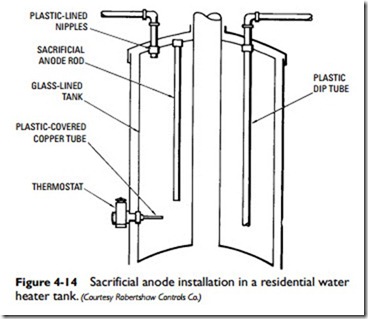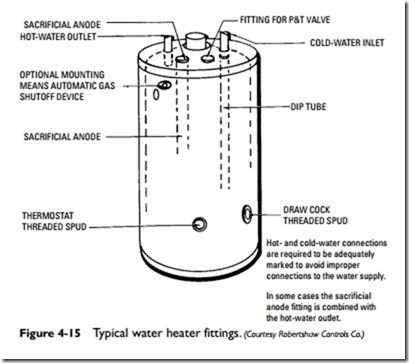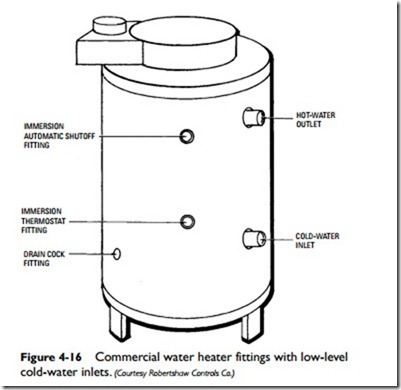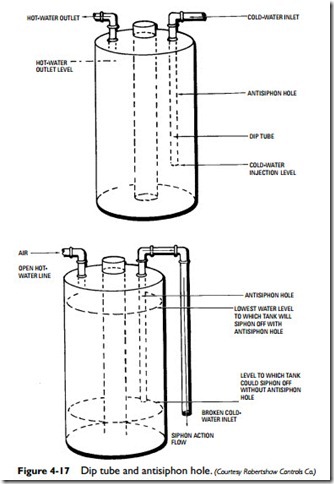Water Heater Construction Details
The automatic controls, fuel-burning equipment (gas burners, oil burner, and so on), and venting system found on a water heater will depend on the type of fuel used and certain other variables. These components are described in detail in appropriate sections of this chapter and elsewhere in the book.
The direct-fired automatic storage water heater is the most commonly used heater in residences. Certain construction details of these heaters remain essentially the same regardless of the type of controls or fuel-burning equipment.
Principal among these are the following:
1. Water storage tanks
2. Tank fittings
3. Dip tubes
4. Anodes
5. Valves
Water Storage Tanks
The tank of a water heater provides storage space for the hot water and also serves as a heat transfer surface. The design and construction of the tank must be strong enough to withstand at least 300 pounds per square inch without leakage or structural deformation.
Corrosion is a major problem in water heater storage tanks. One successful method of reducing corrosion has been to provide steel tanks with glass linings. Older water heater tanks will be found with copper or stone (Portland cement) linings, but these are becoming increasingly rare.
Glass-lined tanks are also equipped with a sacrificial magnesium anode rod, as shown in Figure 4-14. The corrosion process attacks the metal anode rod first, rather than the metal of the tank walls. The anode rod should be removed and replaced before decomposition occurs.
The operating life of a storage tank is directly related to the temperature of the stored water when it is over 140°F. The rule- of-thumb is that each 20° rise above 140°F will reduce tank life by 40 percent.
Tank Fittings
Figures 4-15 and 4-16 illustrate the various fittings required on both domestic and commercial water heaters.
Each tank should have fittings for hot-water outlet and cold- water inlet connections. These water connections generally consist of threaded spuds welded into openings in the tank.
A fitting is also provided in the top of most tanks for the insertion of the sacrificial anode. Other fittings provide for the use of immersion thermostats, immersion automatic gas shutoff devices, drain cocks, pressure and temperature relief valves, and dip tubes.
Dip Tubes
Some water heaters are designed so that the cold-water inlet is at the top of the tank. Because this is also the location of the hot-water supply outlet, there will be an excessive mixing of the cold water with the hot water unless provisions are made to keep the two separated. A dip tube is used for this purpose.
As shown in Figure 4-17, a dip tube is an extension of the cold- water supply pipe and is used to direct the cold water to the bottom
of the tank. On older water heaters, dip tubes were made of metal. Now they are generally made from a high-density, temperature- resistant plastic. In all water heaters, the water at the top of the tank during cycling and intermittent standby conditions is always warmer than the water at the bottom of the tank. If the dip tube is too short, the cold water will mix with the water at the top of the tank and reduce the temperature of the hot-water supply to an unac- ceptable level. On the other hand, a dip tube that is too long will cre- ate an excessive water variation between the top of the tank and the lower thermostat control level. The dip tube must be of sufficient length to avoid both these conditions.
Each dip tube is provided with a small hole near the top of the tank, which functions as an antisiphon device. Sometimes it is possible for a malfunction to close off the cold-water supply while the hot water continues to be removed from the tank. Were it not for the antisiphon hole, the water would be drawn to the bottom
of the dip tube, a dangerously low water level for the tank. The siphon action is broken when the water reaches the level of the antisiphon hole, and the hot water will not be drawn below this level.
Anodes
The inside surface of a domestic hot-water tank is covered with a
coating to protect the steel from corrosion. Sometimes, because of a production error, a very small part of the surface may remain uncoated and subject to corrosion. If another metal with less resistance to corrosion than steel is inserted into the tank, the cor- rosion will attack it instead of the exposed steel surface on the tank wall.
Metal rods called anodes are used to protect the walls of the water storage tank from corrosion. They are made from either magnesium or aluminum formed around a steel wire core. Because both of these metals have less resistance to corrosion than steel, corrosion will attack them instead of the exposed steel. In other words, they sacrifice themselves to the electrolytic process. For this reason, anodes are sometimes called sacrificial anodes.
An anode rod is installed by screwing it into the top of the water storage tank. It can be unscrewed, removed, inspected, and replaced by a new rod. A residential water tank will have one or two anode rods depending on the life of the warranty. Two rods are used in tanks with 12-year warranties. One rod is used if the warranty is half as long. Water storage tanks used in commercial systems will have anywhere from one to six anode rods.
Note
All the anode rods used in a tank must be made of the same metal. Otherwise, some will corrode faster than others.
Valves
Three types of valves are used with domestic hot-water heaters:
temperature and pressure relief valves, vacuum relief valves, and water-tempering valves. These valves are used to prevent damage to the water heater from excessively high pressures, temperatures, or vacuum conditions. They also protect the user from personal injury.
Related posts:
Incoming search terms:
- water heater construction
- construction of water heater
- water heater construction details
- construction of storage water heater
- construction of a storage water heater
- gas water heater construction
- hot water storage tank thermostat
- hot water tank construction
- roof top water storage tanks construction details
- water heater constraction
- Gas hot water heater construction
- gas giser construction
- electric hot water heater construction
- electribwater heater tank construction
- dip pipe in storage tanks
- details of water storage
- design and construction of electric water heater
- contruction storage water
- construction of heater
- construction of gas water heater
- वाटर हीटर कंस्ट्रक्शन



